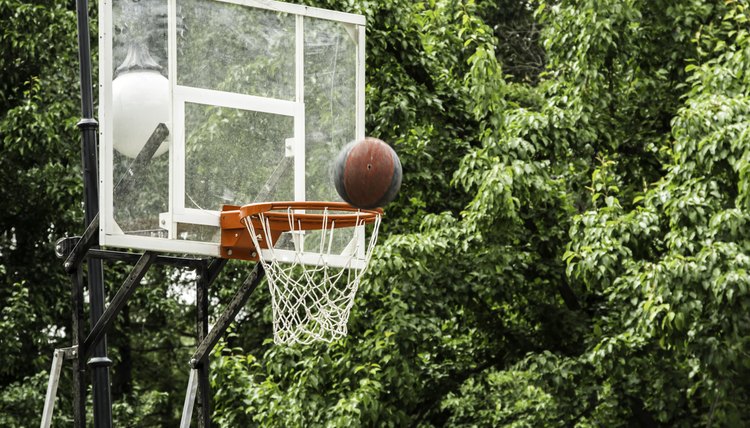Historical Background of Basketball Games

Basketball was not always played on the full-sized basketball court you see today, nor were the players jumping incredible heights to perform slam dunks. The game play of basketball has changed considerably since its inception. The history of the game shows a conceptually similar game to today's version, but with a much different play style, fewer rules, slowed pace and limited-to-no player organization, states William Baker, author of "Basketball: Its Origin and Development."
Origins of Basketball
The game of basketball was developed by Dr. James Naismith in 1891 when he wanted to develop an indoor game during the winter months for students at the School for Christian Workers. His game was intended to utilize player skill to excel. The game was originally played with a soccer ball that was thrown into a peach basket, and thus created the appellation known as "basketball."
Original Court Design
The first basketball courts were only half the size of today's courts. The measurements of the goal have changed little, though. Naismith originally nailed a peach basket on the edge of an indoor track, and its height was ten feet in the air. This height never changed since, and basketball players today still use the 10-foot hoop as a regulation goal. There was also no 3-point line, and shot of considerable distance only counted as a single point; as there was no 2-point shot at this time.
Original Rules
Naismith had only 13 rules that the players had to follow when playing the game. At this point there was no dribbling, and you could only throw the ball from one player to another with a step or two allowance for a player running at considerably speed wen catching the ball. Passes could be made and deflected with one or two hands, and you were not allowed to use your fist to deflect a pass. You were not allowed to forcefully contact an opposing player with your body, and you would be seated or ejected after your second violation of this rule. Some rules that still hold water today include the five-second inbound rule, a ball going through the net counts as a goal and the team with the most points at the end of the game wins.
Game Play of Historical Basketball
Original basketball was considerably slower than today's version. Many adaptations to the game caused the game to become quicker. Naismith called for the bottoms of the baskets to be removed at an early point so that there did not have to be a pause in the game while waiting for the ball to be retrieved. The games themselves were 30 minutes total, with two 15-minute halves, and were typically low scoring due to the fact players could not dribble and had to pass standing still. It was also difficult to move in the smaller courts because there was no regulation on how many players were allowed on the court until 1900. No substitutions were allowed until that point as well, and once you substituted a player they could not come back in and play until 1921. Lastly, there was no shot clock, which slowed the pace of the game also. It seemed the only thing that was exciting for spectators at first was the constant brawls that developed on a constant basis, reports William Baker, author of "Basketball: Its Origin and Development."
Writer Bio
Daniel Bradley is a health, fitness, sport and nutrition expert in Philadelphia, Pa. He began writing professionally in 2007 and has contributed to the Mid-Atlantic American College of Sports Medicine Chapter's Research Panel. Bradley is a certified ACSM Health Fitness Specialist and an outdoor fitness instructor. He holds a Bachelor of Science in exercise science with a physical therapy concentration from West Chester University.
